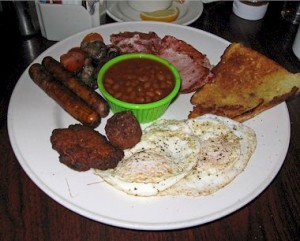We’re continuing our conversation about Irish breakfast with an expert interview. Margaret M. Johnson, author of numerous cookbooks on the Irish culinary arts—including the recent “Tea & Crumpets”—has had ample opportunity to sample Irish breakfasts. We asked her for her views on this distinctive meal.
Q. When you’re in Ireland, I’m guessing that if it comes down to the choice between the Weetabix and the fry-up, you’re going for the fry-up. What is there about this breakfast that is so appealing to you?
A. I think because it’s “the thing to do.” Let’s face it, when you’re on vacation, you tend to “splurge” and a fry-up is really something that most Americans thinks is a no-no on a regular basis (probably most Irish think so, too). Too much fat, cholesterol, etc.
Q. What are the essential elements?
A. Two eggs, bacon, sausage, black and white puddings, mushrooms and tomatoes.
Q. For tourists, sitting down to the “full Irish” seems obligatory. It’s probably how most of us have become familiar with it. But is it likely to be more popular among tourists than among native Irish?
A. Absolutely yes.
Q. Are they secretly starting their day with Pop Tarts or Carnation Instant Breakfast?
A. Probably not Pop Tarts, but perhaps yogurt, fresh fruit, and a bagel.
Q. Is the full Irish breakfast likely to be popular only in certain parts of Ireland—the North, for example—or is it more or less universal?
A. Universal. In the north they add fadge, a fried potato bread.
Q. What they call bacon seems a lot more like what we call ham. It’s really salty and delicious. In what way is it different from our bacon? Seems like it would come maybe from a different part of the pig.
A. It definitely comes from the leg of the pig and is cured differently than American-style bacon. Also less fatty.
Q. I “get” everything about this breakfast except for one thing–the beans. I suspect I’m not alone. At the same time, I think beans on toast is a British and Irish standby, too. Where does this idea of beans as a breakfast food come from?
A. Most hotel breakfasts where tourists are likely to eat do not come with beans. I think beans are a more “home-style” part of a breakfast and come from the fact that these huge breakfasts were meant to serve the workers for a good part of the day—you know, hearty, hearty, hearty.
Q. What they call “puddings” can be a turnoff for some folks. At the same time, a lot of my fellow Philadelphians greatly relish their scrapple. Aren’t they in some ways similar?
A. I’m not too sure abut scrapple. I think the flavor might be similar, but the black pudding in Ireland is made with pig’s blood, oatmeal, and seasonings, which is a turn-off to a lot of people. The white pudding is milder.
Q. Is there one thing on that plate that is not your favorite?
A. I could skip the black pudding, but usually will allow a bite or two of the white. Brown bread, however, is always a winner.
Visit http://www.margaretmjohnson.com/.

